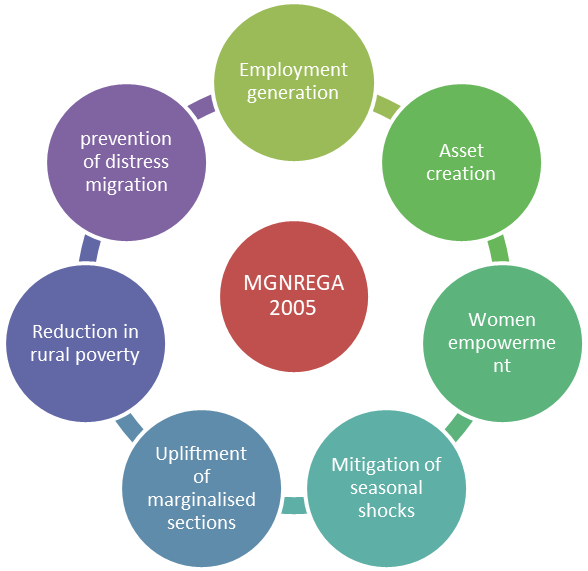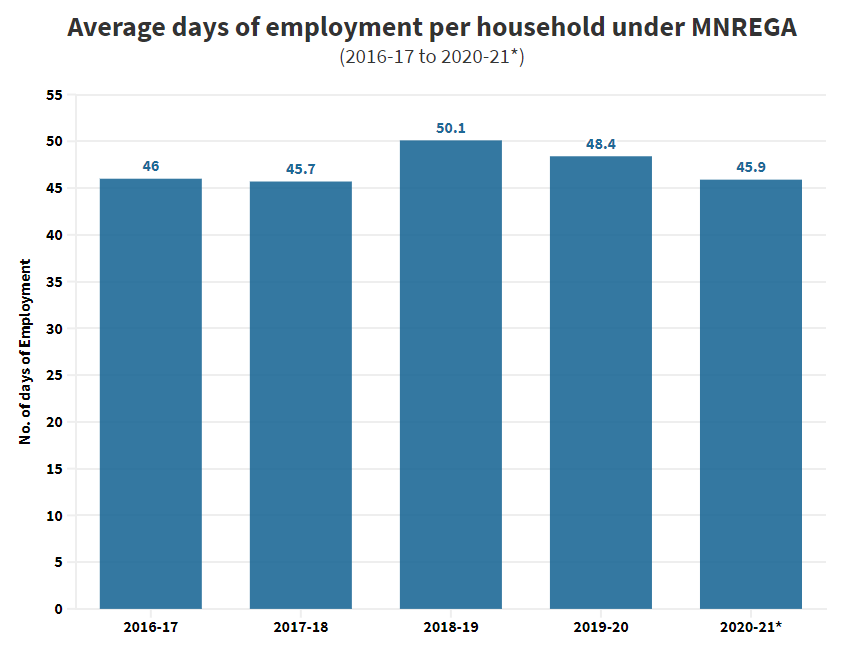Mahatma Gandhi National Rural Employment Guarantee Act (MGNREGA)
2021 NOV 2
Mains >
Social justice > Welfare Schemes > Rural development
IN NEWS:
- According to its own financial statement, the Mahatma Gandhi National Rural Employment Guarantee Act (MGNREGA) scheme shows a negative net balance of Rs. 8,686 crores.
MGNREGA:
- Mahatma Gandhi National Rural Employment Guarantee Act was enacted in 2005 with the primary objective of guaranteeing 100 days of wage employment per year to rural households.
- It aims at addressing the causes of chronic poverty through the works that are undertaken and thus ensuring sustainable development.
KEY FEATURES:
- Legal right to work:
- The Act gives legal guarantee of wage employment to the adult members of rural households who are willing to do unskilled manual labour subject to a maximum of 100 days per household.
- Time bound guarantee of work:
- Employment must be provided within 15 days of being demanded failing which an ‘unemployment allowance’ must be given - atleast one-fourth of the minimum wage for the first 30 days, half of the minimum wage thereafter.
- Eligibility:
- Anyone above the age of 18 years, residing in a rural area and willing to do unskilled work can request for job card.
- At least one third beneficiaries have to be women.
- Nature of works undertaken:
- The Act provides a list of works that can be undertaken to generate employment. They predominantly include those related to water conservation, drought proofing, land development, and flood control and protection works.
- Decentralized planning:
- Panchayati Raj Institutions are primarily responsible for planning, implementation and monitoring of the works that are undertaken. Gram sabhas must recommend the works that are to be undertaken and at least 50% of the works must be executed by them.
- Social audits:
- Section 17 (A) gives the right to the citizen to conduct social audit of all works and expenditure incurred under MGNREGA. Also, all accounts and records relating to the Scheme should be available for public scrutiny.
- Funding:
- Funding is shared between the centre and the states. There are three major items of expenditure – wages (for unskilled, semi-skilled and skilled labour), material and administrative costs:
- The central government bears 100% of the cost of unskilled labour.
- 75% of the cost of semi-skilled and skilled labour.
- 75% of the cost of materials and 6% of the administrative costs.
- Work site facilities:
- All work sites should have facilities such as crèches, drinking water and first aid. If the work is provided beyond 5 kms a travel allowance of 10% of the wage needs to be paid.
SIGNIFICANCE OF MGNREGA:

- Employment generation
- MGNREGA is one of the largest work guarantee programmes in the world. It plays a significant role in ensuring livelihood for people in rural areas.
- Asset creation:
- It leads to strengthening the rural economy through the creation of infrastructure assets, which in turn aids in rural development.
- Economic revival:
- MGNREGA wages improve the purchasing power and help sustain rural demand in the country. Hence it has a vital role to play in the revival of India’s post-covid rural economy.
- This is why Uttarakhand government increased the number of working days guaranteed under MGNREGA from 100 to 150 days.
- Inclusive development:
- MGNREGA has assured the participation of vulnerable sections such as women, Scheduled Castes and Scheduled Tribes (SCs/STs) and other traditionally marginalized sections of society.
- Prevents distress migration:
- As it assures 100 days of employment, it provides a suitable alternative for people who have seasonal employment, like the rural agricultural labourers during off-seasons.
- Enhance social cohesion:
- MGNREGA helps to enhance the social capital, as men and women of different castes and religion work together and socialise with each other across communities.
- Encourage skill development:
- Since 2019, the central government had decided to pay a daily allowance of up to Rs 250 to a casual labourer undergoing skill training for specialised work. The government also undertakes occasional on-site skill training modules on various fields such as masonry and plumbing.
- Manage calamities:
- MGNREGA acts as a safety net for the poorest and most vulnerable population in the country. This enhances their capacity to manage calamities, be it natural or manmade.
- Eg: Under the Act, as many as 1.85 crore people were given work in May, which is 52 per cent higher compared to 1.22 crore in 2019 in the same period.
- Promotes grassroot democracy:
- There is an emphasis on strengthening the process of decentralisation through giving a significant role to Panchayati Raj Institutions (PRIs) in planning and implementing these works.
CHALLENGES:
- low wage rate:
-
- Despite several judicial interventions, MGNREGA wage rates in many states continue to be less than the corresponding state minimum wages. The low wage rates have resulted in lack of interest among workers in working for MGNREGA schemes.
- Insufficient budget allocation:
- A huge surge in demand for MGNREGA works has been witnessed in pandemic times. But the government hasn’t duly allocated funding in a similar proportion.
- Eg: Rs. 73,000 crores have been allocated for the year 2021-22. It is greater than the original allocation of Rs. 61,500 crores for 2020-21. But this is 34.5% lower than the revised estimate of Rs.1,11,500 crores.
- Actual working days:
- While the mandate is to provide at least 100 days of wage employment, the data available on the official portal reveals that the average days of employment provided per household is less than 50.

- Workers penalised for administrative lapses:
- The ministry withholds wage payments for workers of states that do not meet administrative requirements within the stipulated time period (Eg: submission of the previous financial year’s audited fund statements). There is no logical or legal explanation as to why workers would be penalised for such administrative lapses.
- Delay in payment of wages:
- Most states have failed to disburse wages within 15 days as mandated by MGNREGA. In addition, workers are not compensated for a delay in payment of wages.
- Non-payment of unemployment allowances:
- Most states do not pay an unemployment allowance when work is not given on demand. The non-issuance of dated receipts of demanded work prevents workers from claiming an unemployment allowance.
- Issues with caste-based payments:
- Caste based payment system, introduced earlier this year, involved disbursing salaries through three accounts — one for Scheduled Castes (SCs), a second for Scheduled Tribes (STs), and the third for others. This had created an extra layer of red tapism and further delays in payments. Recently the Centre has decided to scrap the system of caste-based wage payments.
- Large number of incomplete works:
- There has been a delay in the completion of works under MGNREGA and inspection of projects has been irregular.
- Poor quality of assets created:
- There is no monitoring mechanism to ensure that assets created meet the required standards. Also, there is limited incentive for workers or local governing bodies to maintain the assets created under MGNREGA.
- Corruption:
- There are several issues related to existence of fake job cards, inclusion of fictitious names, missing entries and delays in making entries in job cards. Also, instances of corruption in the implementation of MGNREGA has been reported from several states.
- Eg: In 2018, Rural Development and Panchayath Raj (RDPR) report pointed out that in FY18 alone, 596 cases were registered against officials and non-officials for violation of rules and guidelines.
- Too much centralization:
- The real-time MIS-based implementation and a centralised payment system has left the representatives of the Panchayati Raj Institutions with literally no role in implementation, monitoring and grievance redress of MGNREGA schemes.
WAY FORWARD:
- Assure 100 days of work:
- The state governments should ensure that the stipulated 100 days of employment is provided to the households. For the same, sufficient fund allocation
- Mandatory social audit:
- NITI Aayog, in its three-year action agenda, has stated that periodic social audits by an independent unit must be mandatorily held for MNREGA.
- Frequent monitoring:
- A Parliamentary Committee had recommended that the frequency of monitoring by National Level Monitors should increase and appropriate measures should be taken by states based on their recommendations.
- Urban MGNREGA:
- To alleviate the covid distress, there has been a proposal that government should bring in a right to employment in urban areas, much like the MGNREGA in rural areas.
- Punishment of offenses:
- Offences such as not recording employment related information in job cards and unlawful possession of job cards with elected PRI representatives and MGNREGA functionaries should be made punishable under the Act.
- Female participation:
- Since the income of female workers typically raises the standard of living of their households to a greater extent than their male counterparts, the participation of women must be increased through raising awareness about MGNREGA.
- Provisions for divyang:
- Special works must be identified for people with disabilities and special job cards must be issued to ensure their participation.
- Emphasis on skilled and semi-skilled work:
- Since states are at various stages of socio-economic development, they have varied requirements for development. There should be more emphasis on skilled and semi-skilled work under MGNREGA.
- Capacity building:
- Training and capacity building of elected representatives and other functionaries of PRIs must be done regularly as it will facilitate their involvement in the implementation of MGNREGA.
PRACTICE QUESTION:
Q. In the Mahatma Gandhi National Rural Employment Guarantee Act, the Government has a potentially effective, even essential, instrument to address the current economic emergency in rural areas. Discuss?

